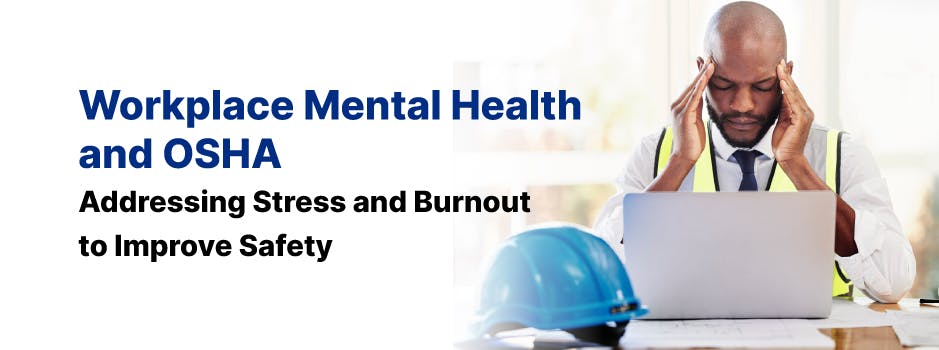Workplace mental health is a critical component of overall employee well-being and can significantly impact workplace safety. In recent years, there has been growing recognition of the importance of addressing stress and burnout in the workplace, with OSHA emphasizing the need for employers to consider these issues as part of their overall safety and health programs. In this blog, we will explore the relationship between workplace mental health and safety, discuss OSHA's role in promoting mental health awareness, and provide practical strategies for employers to address stress and burnout in order to improve workplace safety.
The Impact of Workplace Mental Health on Safety
Mental health issues, such as stress and burnout, can have serious consequences for workplace safety. Employees who are experiencing high levels of stress or burnout may be more prone to making mistakes, have reduced reaction times, and may struggle to concentrate on their tasks. This can result in an increased risk of accidents, injuries, and illnesses in the workplace. Additionally, stress and burnout can contribute to absenteeism and presenteeism, further impacting workplace productivity and safety.
By addressing workplace mental health and promoting a supportive work environment, employers can not only improve employee well-being but also enhance workplace safety and reduce the risk of accidents and injuries.
OSHA's Role in Promoting Workplace Mental Health
While OSHA does not have specific regulations regarding workplace mental health, the agency recognizes the importance of addressing mental health issues as part of a comprehensive workplace safety and health program. OSHA's General Duty Clause, found in Section 5(a)(1) of the Occupational Safety and Health Act, requires employers to provide a workplace that is "free from recognized hazards that are causing or are likely to cause death or serious physical harm" to employees. This includes hazards related to workplace stress and mental health.
OSHA encourages employers to consider the impact of mental health on workplace safety and to implement strategies to address stress and burnout as part of their overall safety and health programs. Employers can also consult OSHA's guidelines, resources, and best practices related to workplace mental health and stress management to help inform their efforts in this area.
Strategies for Addressing Stress and Burnout in the Workplace
Employers can take several proactive steps to address workplace stress and burnout and promote a mentally healthy work environment. Some strategies to consider include:
- Assess the workplace: Conduct regular assessments to identify sources of stress and burnout, such as excessive workloads, tight deadlines, or lack of control over work processes. Use this information to develop targeted interventions and improvements.
- Encourage open communication: Create a supportive workplace culture where employees feel comfortable discussing mental health concerns and stressors. Encourage managers and supervisors to engage in open conversations about mental health and stress with their teams.
- Provide resources and support: Offer access to resources and support services, such as employee assistance programs (EAPs), mental health counseling, and stress management workshops, to help employees cope with stress and burnout.
- Promote work-life balance: Encourage employees to take regular breaks, use their vacation time, and set boundaries between work and personal life. Consider implementing flexible work arrangements or remote work options to help employees achieve better work-life balance.
- Offer training and development: Provide training and development opportunities to help employees build resilience and coping skills, as well as develop effective stress management strategies.
Integrating Mental Health into Workplace Safety and Health Programs
In order to effectively address workplace mental health and its impact on safety, employers should consider integrating mental health strategies into their existing safety and health programs. This can be achieved by:
- Including mental health and stress management topics in safety training and education programs
- Incorporating mental health risk assessments as part of the overall hazard identification and assessment process
- Developing policies and procedures that support mental health and well-being, such as anti-bullying and harassment policies, and guidelines for reasonable work hours and workloads
- Encouraging employee involvement in the development and implementation of mental health initiatives, fostering a sense of ownership and commitment to mental health and safety
- Regularly monitoring and evaluating the effectiveness of mental health strategies and making adjustments as needed to ensure continuous improvement in workplace mental health and safety
The Benefits of Addressing Workplace Mental Health
Investing in workplace mental health not only helps to improve employee well-being, but it can also have a significant positive impact on workplace safety and overall business performance. Some of the benefits of addressing stress and burnout in the workplace include:
- Reduced risk of accidents, injuries, and illnesses related to mental health issues
- Improved employee morale, engagement, and job satisfaction
- Reduced absenteeism and presenteeism, leading to increased productivity
- Enhanced ability to attract and retain top talent
- Strengthened reputation as an employer that values employee well-being and safety
Conclusion
Workplace mental health is an essential component of employee well-being and can have a significant impact on workplace safety. By recognizing the importance of addressing stress and burnout, and implementing effective strategies to promote a mentally healthy work environment, employers can improve both the safety and overall performance of their organizations. OSHA's focus on workplace mental health serves as a reminder for employers to prioritize mental health and well-being as part of their comprehensive safety and health programs.

